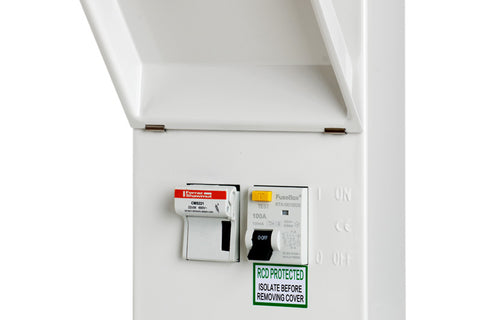Comprehensive Guide to Consumer Units
Consumer Units
A consumer unit, commonly referred to as a fuse box or distribution board, serves as the nucleus of an electrical system in homes and buildings. Its vital role in ensuring secure and efficient electricity distribution makes understanding its intricacies paramount. In this in-depth guide, we will delve into the realm of consumer units, examining their purpose, different types, installation procedures, and maintenance protocols. Whether you're a homeowner, a landlord, or an avid DIY enthusiast, comprehending consumer units is indispensable for establishing a safe and functional electrical framework.
What is a Consumer Unit?
At its core, a consumer unit acts as a central hub for the electrical system in a dwelling or structure. It receives power from the main supply and channels it to different circuits, energizing lights, appliances, and other electronic devices. Safeguarding against overloads and short circuits, consumer units incorporate fuses or circuit breakers as protective mechanisms. The evolution from traditional fuse boxes to modern circuit breaker panels has augmented both safety and convenience within consumer units.

Importance of a Consumer Unit
-
Electrical Safety: The chief objective of a consumer unit is to amplify electrical safety. By thwarting overcurrents and faults, it mitigates the risk of electrical fires and potential dangers.
-
Energy Efficiency: A well-engineered consumer unit facilitates energy-efficient power distribution, ensuring devices receive suitable electricity levels while minimizing wastage.
-
Convenience: Contemporary consumer units often encompass advanced attributes like residual current devices (RCDs) and miniature circuit breakers (MCBs), promptly detecting faults and tripping circuits to avert possible mishaps.
Different Types of Consumer Units
-
Main Switch Consumer Units: Also known as RCBO consumer units - These units feature a main switch for disconnecting the entire electrical supply, making them suitable for properties with specific isolation requirements.
-
Dual RCD Consumer Units: With two RCDs, these units offer enhanced safety by dividing circuits into two separate RCD-protected groups, reducing the risk of complete power loss due to a single fault.
-
RCD Incomer Consumer Units: In these units, the RCD provides protection at the point where electricity enters the property, safeguarding all downstream circuits.
-
EV Charging Consumer Units: Designed for electric vehicle charging, these units include dedicated circuits and RCD protection to ensure safe and efficient charging.
-
Garage Consumer Units: Tailored for outbuildings like garages or sheds, these units enable independent power distribution to external structures.
-
Dual Tariff Consumer Units: Ideal for properties with dual electricity tariffs (e.g., day and night rates), these units facilitate separate metering and distribution for different tariff periods.

Installation of a Consumer Unit
Consumer unit installation is a specialized task best entrusted to certified electricians, given its intricate nature. Here is an outline of the fundamental installation steps:
-
Assessment: An electrician assesses the property's electrical load requirements to ascertain the optimal size and capacity of the consumer unit.
-
Wiring Upgrade: In select cases, upgrading the wiring may be necessary to accommodate the demands of contemporary electrical appliances and technologies.
-
Unit Selection: Drawing upon the assessment, an electrician selects a suitable consumer unit, factoring in considerations such as circuit quantity and requisite protection.
-
Wiring and Connection: Wiring the consumer unit involves linking it to the primary power supply and creating distinct circuits for different sections of the property.
-
Testing and Certification: Rigorous testing ensures proper functioning and safety post-installation. Following successful tests, the electrician furnishes certification attesting to compliance with electrical regulations.

Maintenance and Care
Maintaining consumer units is vital to perpetuate functionality and safety. Consider the following maintenance practices:
-
Routine Inspections: Schedule periodic inspections by a qualified electrician to identify wear, damage, or corrosion. These assessments preempt potential issues from escalating.
-
Circuit Protection Update: As technology advances, electrical needs evolve. Consider updating the consumer unit to accommodate novel circuits and protective devices.
-
Circuit Labeling: Adequate labeling of each circuit on the consumer unit expedites identification of the corresponding property section, streamlining troubleshooting and maintenance.
-
Accessibility: Ensure unimpeded access to the consumer unit, eliminating clutter that might hinder electricians and ensuring safety during any maintenance tasks.

Incorporating RCBOs and AFDDs
Recent advancements have introduced additional safety measures for consumer units, including Residual Current Breaker with Overcurrent (RCBO) devices and Arc Fault Detection Devices (AFDDs).
-
RCBOs: These devices combine the functions of RCDs and MCBs, providing protection against both earth leakage and overcurrents on individual circuits. They enhance safety by promptly isolating faulty circuits.
-
AFDDs: AFDDs detect potentially hazardous arc faults, such as those caused by damaged cables or connections, and swiftly disconnect the circuit. This preventive measure significantly reduces the risk of fire.

Conclusion
The consumer unit stands as a cornerstone of electrical infrastructure, prioritizing safety and facilitating efficient power distribution. Delving into the nuances of consumer units equips homeowners, landlords, and responsible individuals with the knowledge necessary to uphold safety and functionality. Whether contemplating installation or an upgrade, consulting a licensed electrician ensures a secure and well-maintained electrical system. Embrace the power of consumer unit management to foster tranquility and a seamlessly operational living environment.
Find the correct sized consumer unit here!











